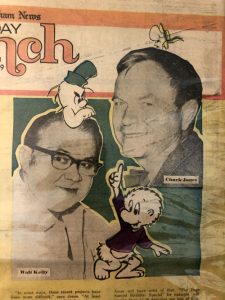 When Chuck Jones went over to MGM, he many relied on characters created by others. Some like How the Grinch Stole Christmas and The Dot and the Line were masterpieces. Others, like his Tom and Jerry shorts, were not among his best work. The Pogo Birthday Special disappointed many fans of the strip and never captured the charm or appeal of Kelly’s characters. It was one of the most disappointing things Jones ever did. The special didn’t satisfy anyone, particularly Walt Kelly, which you can read about in Jim Korkis’s Cartoon Research article about the special. However, the history and publicity of the special are fascinating. Many newspapers across the country devoted whole pages to the special. Chuck Jones, Walt Kelly, and June Foray were interviewed about the special. In this Cartoon Research post, I am going to share a few of these articles. One of which for the Birmingham News, I actually found at a local bookstore. There are a few typical reporter-type mistakes, such as that Chuck was the first to get to animate Dr. Seuss’s characters. The genesis for the special partially came from Chuck’s grandson Todd Kausen. More about that will be discussed in my next post for Cartoon Research (next week!).
When Chuck Jones went over to MGM, he many relied on characters created by others. Some like How the Grinch Stole Christmas and The Dot and the Line were masterpieces. Others, like his Tom and Jerry shorts, were not among his best work. The Pogo Birthday Special disappointed many fans of the strip and never captured the charm or appeal of Kelly’s characters. It was one of the most disappointing things Jones ever did. The special didn’t satisfy anyone, particularly Walt Kelly, which you can read about in Jim Korkis’s Cartoon Research article about the special. However, the history and publicity of the special are fascinating. Many newspapers across the country devoted whole pages to the special. Chuck Jones, Walt Kelly, and June Foray were interviewed about the special. In this Cartoon Research post, I am going to share a few of these articles. One of which for the Birmingham News, I actually found at a local bookstore. There are a few typical reporter-type mistakes, such as that Chuck was the first to get to animate Dr. Seuss’s characters. The genesis for the special partially came from Chuck’s grandson Todd Kausen. More about that will be discussed in my next post for Cartoon Research (next week!).
This first article was seen in many newspapers across the country. The article includes quotes from both Walt Kelly and Chuck Jones. Here is its reprint in the Birmingham News Friday Punch (May 9th, 1969) combined with additional sections from the Herald-Mail (May 17, 1969). In some ways, his discussion about adapting materials from other creators is why this special didn’t work. Chuck was able to capture the charm of Suess. But he missed on this one by straying away from what made Pogo such a wonderful character.
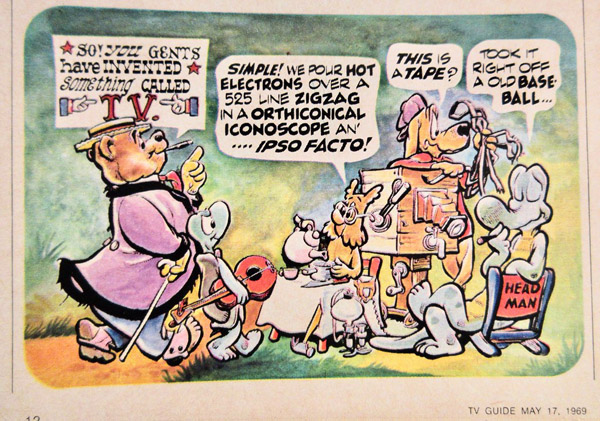
Animation: The Art of the Impossible
“We engrave the Gettysburg address on the head of a pin, but on a production line basis.”
This is the way Chuck Jones, head of MGM’s animation-visual arts department and three-time Oscar winner, describes his calling. “It is,” Jones says, “the art of the impossible,” but he says he loves it. He must; he’s been doing it for more than 25 years.
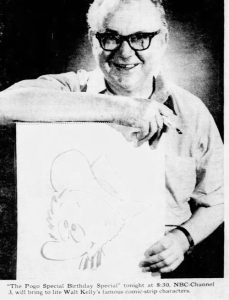 That he loves his work is apparent, not only to audiences, but also to people like “Pogo’s” creator, Walt Kelly, and famed children’s book author, Dr. Seuss. Dr. Seuss wouldn’t let anyone touch his characters until Jones asked to do an animated special, and now “Pogo” will come to life on television screens for the first time because Walt Kelly has implicit faith in Jones’ taste and creative talents in animation.
That he loves his work is apparent, not only to audiences, but also to people like “Pogo’s” creator, Walt Kelly, and famed children’s book author, Dr. Seuss. Dr. Seuss wouldn’t let anyone touch his characters until Jones asked to do an animated special, and now “Pogo” will come to life on television screens for the first time because Walt Kelly has implicit faith in Jones’ taste and creative talents in animation.
As Kelly puts it, “Jones is a man who really knows what he’s doing. That’s why I said ‘yes’ when he approached me about doing a special with “Pogo.”
On Sunday, May 18, On NBC-TV, “The Pogo Birthday Special,” starring the world famous possum and 10 other characters from the Okefenokee Swamp, will have its premiere airing at 8 p.m. on Channel 42. The 30-minute program will be a culmination of nearly two years work for MGM’s animation-visual arts department and cartoonist Kelly.
Why does Jones call animation the art of the impossible? As he explains it, “It’s taking something that doesn’t exist and making it real, making it believable, bringing it to life on the screen.”
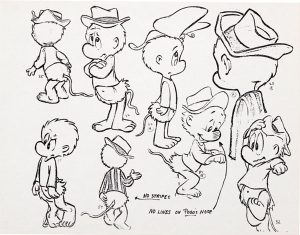 During the past quarter of a century, Jones has not only made something real of things that didn’t exist before, but some of his characters have become worldwide film stars. Besides Pepe Le Pew and the Road Runner, both of which he originated, he collaborated on “Daffy Duck”, “Porky Pig”, “Henry Hawk”, “Elmer Fudd” and possibly the most successful and enduring character ever drawn, “Bugs Bunny”.
During the past quarter of a century, Jones has not only made something real of things that didn’t exist before, but some of his characters have become worldwide film stars. Besides Pepe Le Pew and the Road Runner, both of which he originated, he collaborated on “Daffy Duck”, “Porky Pig”, “Henry Hawk”, “Elmer Fudd” and possibly the most successful and enduring character ever drawn, “Bugs Bunny”.
More recently, Jones is noted for his collaboration with Dr. Seuss on “How the Grinch Stole Christmas” which has already become a Yuletide television tradition in only three years. Another book, “The Dot and the Line” by Norton Juster, became an animated short under Jones’ direction winning him his third Academy Award.
“In some ways, these recent projects have been more difficult,” says Jones. “At least they’ve required more discipline, because we’re taking characters that already have identity, and bringing them to life. People know what they look like in a still form, so when they get up and move and talk, they must be logical extensions of what has gone before.”
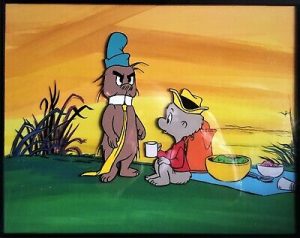 Believability is not easy to come by when animating for motion pictures or television. There are short cuts, which some producers use, sacrificing believability, but Jones will have none of that. “The Pogo Special Birthday Special” for example, will require from 12-16 drawings per foot of film, and there are close to 2,500 feet of film in the half-hour show, making a total of approximately 40,000 finished drawings, which have to be inked and painted as well, before they are filmed in full color.
Believability is not easy to come by when animating for motion pictures or television. There are short cuts, which some producers use, sacrificing believability, but Jones will have none of that. “The Pogo Special Birthday Special” for example, will require from 12-16 drawings per foot of film, and there are close to 2,500 feet of film in the half-hour show, making a total of approximately 40,000 finished drawings, which have to be inked and painted as well, before they are filmed in full color.
“The average animator can do about three seconds of film a day in drawings,” says Jones, “so you see what I mean about the head of a pin. And of course, I haven’t even mentioned the hundreds and even thousands of preliminary sketches that we do in laying out a show. Those are all discarded as we do the finish drawings for film.”
Nor did he mention the background paintings t h a t must be done for every scene, just as a live action film must have sets. But the details of getting an animated special on the air are so infinite that Jones hesitates to try to describe everything. One of his favorite answers to people who ask him what he does is, “I produce whimsy by the yard.”
The next interview was with June Foray. A few mistakes still are in the article which is typical of newspapers writing about cartoons during this time (she is credited as the voice of Alvin and Depatie-Freleng is spelled wrong). Also, the reporter includes himself in the interview, making it a bit sporadic. In the special, she voices Pogo, Mam’selle Hepzibah, and Miz Weevil.
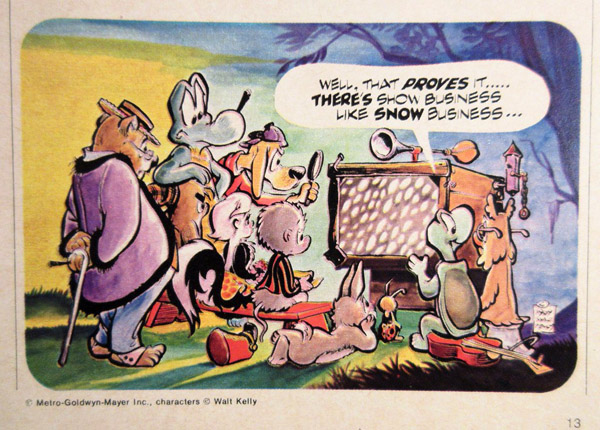
Pogo’s New Picture (The Honolulu Advertiser May 16, 1969) By Vernon Scott
“Pogo,” the precious little opossum of the comic strip, comes to animated life this month in a television special featuring the inhabitants of the Okefenokee swamp.
Illusion shattering though it may be, the public is entitled to know that the voice of Pogo belongs to June Foray, a voice specialist who has provided vocal cords for virtually thousands of animated cartoon characters as well as live actors.
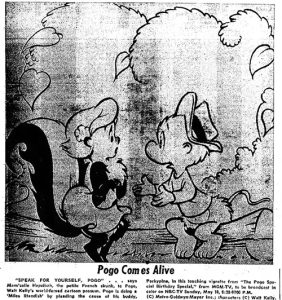 A tiny woman with huge eyes, Miss Foray’s voice ranges from bass to soprano. She provides the voice for Rocky and Natasha in the “Bullwinkle” show; Jerry in “Tom and Jerry” and Alvin the chipmunk. Her versatile epiglottis also gives voice to assorted woodpeckers, bears, pigs, dogs, cats, chickens and skunks. Give June an animal and she will give it a voice.
A tiny woman with huge eyes, Miss Foray’s voice ranges from bass to soprano. She provides the voice for Rocky and Natasha in the “Bullwinkle” show; Jerry in “Tom and Jerry” and Alvin the chipmunk. Her versatile epiglottis also gives voice to assorted woodpeckers, bears, pigs, dogs, cats, chickens and skunks. Give June an animal and she will give it a voice.
“When I was hired to play Pogo, the director said he wanted a straight young southern boy voice about 12 years old,” June said, giving a brief sample of Pogo’s drawl.
“We decided against a hokey cartoon character for him.”
Titled “Pogo Special Birthday Special,” the redundantly named show will be beamed in Hawaii via KHON Saturday night at 6 o’clock, but it is not Pogo’s birthday. It is Porky Pine’s birthday.
And how does that grab you?
In addition to doing Pogo’s voice, June will speak for six other characters in the show, including Miss Mamselle Hepzibah, a skunk with a French accent.
“I can do every accent and dialect in the world,” June said without fear of contradiction.
“What about upper Mongolian?”
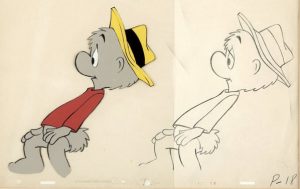 “Well I haven’t heard that dialect,” she responded. “But let me hear it for two minutes and I’ll be able to do a Mongolian bit.”
“Well I haven’t heard that dialect,” she responded. “But let me hear it for two minutes and I’ll be able to do a Mongolian bit.”
June has worked for every major cartoon studio in Hollywood Disney, Hanna-Barbera, MGM, DePatie-Freling, Walter Lantz and Jay Ward.
Often she will dash to three different studios in a single day to record a variety of voices. Not infrequently she plays multiple roles and finds that she is talking to herself in the course of the dialogue for cartoon characters.
In the process, June Foray has become a wealthy woman. Like Mamie Nixon, who sings for tone-deaf stars, June is heard more often than seen, although she has appeared with Red Skelton and others.
“It’s a very specialized field,” June concluded.
“There are about 100 people in the business, but only six or seven of us work regularly.”
They are stars in their own rights, but only people who work behind the scenes in Hollywood know them.
Source Credits and thanks to Kurtis Findley, Jim Korkis, the Levitows (Jon, Judy, and Roberta), Linda Jones Clough, Todd Kausen, Mark Evanier, and the Van Eaton Galleries


 Kamden Spies is an animation fan, collector, and aficionado. He received his undergraduate degree in an IDM in film history and creative writing from the University of Alabama at Birmingham and is currently getting his Master’s in Library and Information Sciences at Indiana University Bloomington.
Kamden Spies is an animation fan, collector, and aficionado. He received his undergraduate degree in an IDM in film history and creative writing from the University of Alabama at Birmingham and is currently getting his Master’s in Library and Information Sciences at Indiana University Bloomington.

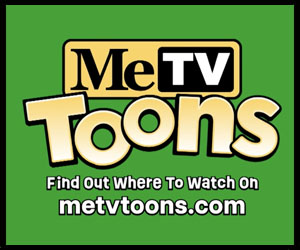
















































This special was not without its impact. I can vouch for one nine-year-old fan who came on board through viewing “The Pogo Special Birthday Special.” From this point on, I followed the comic strip avidly and began collecting the many books that were available at the time.
Publicity for this special was off the charts! The characters were featured on the cover of Jack & Jill Magazine (which every kid I knew had a subscription to) plus the magazine had a promotional article featuring color photos of scenes. Likewise, the local newspaper television booklets promoted it heavily, as well as TV Guide. There were plastic toys of six of the characters available with the purchase of Biz Bleach. My mother rather grudgingly bought six or more big boxes of Biz Bleach so that I could get all the characters. We used Biz on our laundry for a couple of years after that. The Pogo books were prominently on display in bookstores, and from then on Pogo became a household word, not only among my friends, but in the classroom as well. Teachers would often make reference to Pogo (which I don’t recall happening much before the airing of the special) and there was definitely an elevated consciousness of the characters and the comic strip in general.
I’m sure if it won me, it must have won many other fans as well. And as the nation entered what was to become politically one of the most cynical and controversial periods in American history, the humor of Pogo gained relevance. Pogo’s most popular catch-phrase emerged right around this time. (Do I need to quote it? I don’t think so! We could probably all say it together. One, two, three…) Much of this increased popularity and public consciousness, I am sure, resulted either directly or indirectly from this television special and the attendant publicity.
I agree that it probably gained traction with younger audiences who were unfamiliar with the strip. I think more people probably saw this than I Go Pogo as well. I’m not sure of that though
“I could a tale unfold whose lightest word
Would harrow up thy soul, freeze thy young blood,
Make thy two eyes, like stars, start from their spheres,
Thy knotted and combined locks to part,
And each particular hair to stand on end
Like quills upon the fretful porpentine.” — Hamlet, Act I, Scene v
The tale unfolded by Chuck Jones might have elicited a similar reaction from fans of Walt Kelly’s comic strip, but in all fairness I don’t think anyone could have done it justice. Kelly’s complex, multi-layered wordplay really needs to be savoured on the printed page in order to be fully appreciated. Spoken or sung in a television production, it comes across as mere whimsy at best and incomprehensible gibberish at worst. That’s why there have been so few cartoon adaptations of “Finnegans Wake”.
Another problem is the special’s ostensibly heartwarming denouement, spoiled by Porky’s apparent indifference to his friends’ kindness and Mlle. Hepzibah’s affection. From first to last, he remains an unsympathetic, fretful porpentine — that is, porcupine. Of course, if he had started grinning and dancing for joy amid a flourish of cartoon hearts — and we can all imagine how Chuck Jones would have handled such a scene — he would have ceased to be Porky. But then what was the whole point?
(As a young boy, it took me forever to figure out that Porky was meant to be a porcupine. I couldn’t tell if he was a pine cone, a whisk broom, a month-old potato, or what.)
Those newspaper articles reminded me why I have so little respect for feature writers. Imagine being lucky enough to interview Chuck Jones and June Foray, and then turning it into such drivel. “…Jones hesitates to try to describe everything.” He was probably thinking: “Let’s see, how can I dumb it down enough for this idiot reporter to understand?”
June’s interview doesn’t seem to work well in print either. Asking her to do the voice makes no sense in a printed conversation.
The author of the Foray article needed to brush up on his anatomy. Trying to use a fancy word, he wrote that Ms. Foray had a “versatile epiglottis.” The epiglottis is merely the flap to prevent food from going down the windpipe. The correct word is “larynx.”
I’ve read for years and years that no model sheets were produced for the Pogo special , and that the animators consulted the reprint books for reference instead. Looks as if another longtime animation fallacy has bit the dust.
Considering how Kelly felt about the finished special, I’m surprised he praised Jones in that first article. Was he being diplomatic? Was he quoted before he saw the final product? Or was that the only kind word he had to say and the rest was omitted because it wasn’t fit for print?
My money’s on the possibility that the reporter never spoke with Kelly at all and simply made the quote up. Not cricket for hard news, of course, but in weekend supplement features it happens all the time.
It’s real. I believe he used that quote from a previous article done elsewhere before the special was finished. Right about the time it was being first developed. More on that next week though.
Hanna-Barbera cast Janet Waldo as Dorothy on their Snagglepuss record..Janet would sound cute, even though that,too became a bit of type casting
There’s also the question of Jones’ adaptation of his former colleague Frank Tashlin’s “The Bear That Wasn’t,” which came out in this era, and was another case where the creator didn’t like Jones’ take.
Not to mention what he did to “Wizard of Oz.” He even put Dorothy (voiced by June Foray–even Filmation had the brains to get Liza Minnelli for their “Return to Oz”) in a pink dress.
I don’t think that really counts considering those were interstiuals and not a real special.
Good work Kamden! Funny how Jones had gotten a little bit ambitious with adapting characters after the success of GRINCH. Part of me wonders if pressure from the heads of MGM were causing him to do some of these rather than true passion, but that’s a different tale. Afterall, the idea for Pogo wasn’t even from MGM but Jones’ own kid
I remember getting the Pogo Possum and Porky Pine figures not long after the special and hanging on to them. I don’t recall when I first started reading the strip but I reread our dogeared copy of “I Go Pogo” several times.
During this century I gradually found the other four detergent figures at flea markets; the half dozen now stand guard by my paperbacks and the more recent hardbound strip reprints.
Also remember those TV Guide drawings. There was one more where Porky was about to take an axe to a cable connecting to the television. Bun Rabbit assures him it’s not a serpent. Porky says “I know what I’m doing.”
Another reason why Porkypine has always been my favorite character in the strip.
It’s doubtful whether Walt Kelly’s alma mater Disney would have brought “Pogo” to life any more satisfactorily. Adapting comic strips to animation is not as easy as you’d think, particularly when there’s any kind of satiric element (which is usually the first thing to go).
I remember this special when it came out, and read a number iof years how Walt Kelly said, “That (unprintable) Chuck Jones! after what he DID to my strip!” Coincidental for a Porky director to do another famed Porky…Steve C
You know I don’t think I’ve read about the reason why MGM Animation/Visual arts shut down. I wager it was due to Aubrey’s massive layoffs at MGM during that time.
I know the studio was located in the former Sunset Vine Tower, floor 12 from what I’ve gathered (I guess that’s why it was formerly called SIB Tower 12?, SIB was a remnant of Walter Bien’s company). But did the studio occupy more than 1 floor or just that one? Someone who knows, please do inform me.
Just came across this article and well done Kamden. I noticed the Chuck Jones animated version has Pogo with a red shirt. I have seen versions of Pogo on animation cells with his red/black striped shirt…wonder where those came from? Possibly prelim work Kelly did with Disney Bill Tytla????
….found this
Cels from lost 1969 Pogo Possum commercial
Sometime ago, I became interested in a late 1940s comic strip called Pogo by Walt Kelly and it had an animated adaptation in 1969 called “The Pogo Special Birthday Special” directed by Chuck Jones. I looked it up on google one day and found these animation cels while looks identical to the special on the surface, it looks a bit different (the biggest giveaway is that Pogo’s shirt is striped when it was solid red in the special). After some deep digging, I found out that it was an animated sponsor for Procter and Gamble since at the same time, they were selling free Pogo figures packaged within their various laundry detergents like Downy and Biz. I have been looking high and low for it but can’t find it outside from these cels.